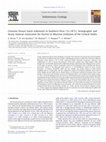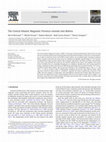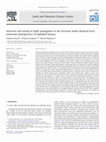Papers by Thierry Sempere

New data from the Mal Paso Palca area (Tacna) and reinterpretations ofpublished information lead ... more New data from the Mal Paso Palca area (Tacna) and reinterpretations ofpublished information lead to reformulate the local to regional geologic history. This evolution was dominated by a long process of Iithospheric thinning that started in the Late Paleozoic, the local growth of a volcanic arc starting in the Early Cretaceous, and its migration to its current location in the Late Eocene or earliest Oligocene. During its incipientstage, the Late Paleozoic rifting produced grabens where the Machani Formation and Ambo Group were deposited. Lithospheric thinning seems to have reached in the Pennsylvanian a stage sufficiently advanced to allow the production of considerable amounts of basic magma, and the accumulation of the submarine basaltic flows that form the thick J unerata Formation. lt is likcly that this evolution created a marginal basin south of what is today the lncapuquio fault system. The study area was located across the northeastern, passive-type, margin of this basin. The...
Bulletin de la Société Géologique de France, 1988
Dans le domaine vocontien, deux vallées sous-marines convergentes canalisent durant le Berriasien... more Dans le domaine vocontien, deux vallées sous-marines convergentes canalisent durant le Berriasien d'épais dépôts gravitaires carbonatés (slumps, coulées à débris). La vallée principale (de Saillans-Ceiise) est caractérisie par un creusement puis un comblement rétrogradants, d'aval en amont ; la vallée adjacente (de Die) sert de lieu de transit notamment a des sédiments graveleux issus des plates-formes septentrionales. Ces facies particuliers édifient un éventail carbonaté au débouché dans la vallée majeure. Submarine valleys and carbonate deep-sea fans during Berriasian in the Vocontian area (southern French Alps)
Bulletin de la Société Géologique de France, 1984
Discontinuités et séquences dans la formation de Tarat (Viséen supkrieur) et l'unité d'Arlit (Nam... more Discontinuités et séquences dans la formation de Tarat (Viséen supkrieur) et l'unité d'Arlit (Namuro-Westphalien) à M i t (Niger). Évolution sédimentaire, climatique et tectonique de la région au Carbonifère par THIERRY SEMPERE * et BERNARD BEAUDOIN ** dlots clés.

Sedimentary Geology, 2011
A large sedimentary forearc basin developed in Cenozoic times between the present-day Coastal Cor... more A large sedimentary forearc basin developed in Cenozoic times between the present-day Coastal Cordillera and the Western Cordillera of the Central Andes, called Moquegua basin in southern Peru. The basin is filled by Moquegua Group deposits (~50 to 4 Ma) comprising mostly siliciclastic mudstones, sandstones and conglomerates as well as volcanic intercalations. Several facies changes both, along orogenic strike and through time, are described and have led to subdivision into four sedimentary units (Moquegua A, B, C and D). In this paper we present a refined stratigraphic scheme of the Moquegua Group combined with the first provenance analysis of the Moquegua basin based on (i) semi-quantitative analysis of heavy mineral abundance, (ii) electron microprobe (EMP) and laser ablation (LA) ICP-MS analyses of single detrital amphibole and Fe-Ti oxide grains, and (iii) comparative analysis of the different potential source rocks to clearly identify the most likely sources. Results allow us to reconstruct sediment provenance and to relate changes of the erosion-sedimentation system in the Moquegua basin to the evolution of the Andean orogen. At~50 to~40 Ma the Moquegua basin was close to sea level and fed by low energy rivers transporting mainly metamorphic basement and Jurassic-Cretaceous sedimentary detritus from local and distal sources. The latter might be as far as the present Eastern Cordillera. From~35 Ma on the distal sediment sources were cut off by the uplift of the Altiplano and Eastern Cordillera leading to higher energy fluvial systems and increasing importance of local sources, especially the relevant volcanic arcs. From 25 Ma on volcanic arc rocks became the predominant sources for Moquegua Group sediments. The 10 Ma time lag observed between the onset of uplift-induced facies and provenance changes (at~35 Ma) and the onset of intense magmatic activity (at~25 Ma) suggests that magmatic addition was not the main driver for crustal thickening and uplift in the Central Andes during latest Eocene to Oligocene time.

Molecular Phylogenetics and Evolution, 2007
The cyst nematode Globodera pallida is a major pest of potato in South America where this special... more The cyst nematode Globodera pallida is a major pest of potato in South America where this specialist parasite is native. To investigate its phylogeography, we have genotyped individuals from 42 Peruvian populations using mitochondrial and nuclear molecular markers. A clear south-to-north phylogeographical pattern was revealed with five well-supported clades. The clade containing the southern populations is genetically more diverse and forms the most basal branch. The large divergence among cytochrome b haplotypes suggests that they diverged before human domestication of potato. As the nematodes studied have been sampled on cultivated potato, multiple host-shifts from wild to cultivated potatoes must have occurred independently in each clade. We hypothesise that this south-to-north pattern took place during the uplift of the Andes beginning 20 My ago and following the same direction. To our knowledge, this is the first study of a plant parasite sampled on cultivated plants revealing an ancient phylogeographical pattern.

Lithos, 2014
Ar/ 39 Ar age Basalt The Central Atlantic Magmatic Province (CAMP) is the largest continental flo... more Ar/ 39 Ar age Basalt The Central Atlantic Magmatic Province (CAMP) is the largest continental flood basalt (CFB) province on Earth and was associated with the onset of fragmentation of the supercontinent Pangea at the Triassic-Jurassic boundary. In order to clarify the extent of the CAMP in South America, we investigate basaltic remnants in southern Bolivia (Tarabuco, Entre Ríos and Camiri areas) by combining stratigraphic, geochronological (40 Ar/ 39 Ar data) and geochemical (major and trace element, Nd-Sr isotopes) approaches. Lava-flows reaching a total thickness up to 150 m and associated sills overlie syn-rift red beds assigned to the Triassic. The magmatic rocks consist of low-Ti tholeiites that are remarkably homogeneous in composition. Notably, their trace element and Nd-Sr isotopic compositions closely match those of CAMP basalts particularly those of southwest Brazil. 40 Ar/ 39 Ar dating failed to yield robust plateau ages but the best estimates of the crystallization age at 198.1 ± 1.5 and 199.2 ± 2.2 Ma are similar to those of CAMP basalts throughout the province. These Bolivian basalts, which may have covered an initial surface of~30,000 km 2 , represent the known southernmost occurrence of the CAMP. They were erupted as a single pulse, more than 8000 km away from the northern edge of the province. We discuss the implications of such a huge elongated CFB for the current plume models and we suggest, as an alternative, that large-scale melting beneath the Pangea supercontinent due to mantle global warming could have triggered the emplacement of the CAMP.

Earth and Planetary Science Letters, 2008
Physical paleoaltimetric methods are increasingly used to estimate the amount and timing of surfa... more Physical paleoaltimetric methods are increasingly used to estimate the amount and timing of surface uplift in orogens. Because the rise of mountains creates new ecosystems and triggers evolutionary changes, biological data may also be used to assess the development and timing of regional surface uplift. Here we apply this idea to the Peruvian Andes through a molecular phylogeographic and phylochronologic analysis of Globodera pallida, a potato parasite nematode that requires cool temperatures and thus thrives above 2.0-2.5 km in these tropical highlands. The Peruvian populations of this species exhibit a clear evolutionary pattern with deeper, more ancient lineages occurring in Andean southern Peru and shallower, younger lineages occurring progressively northwards. Genetically diverging G. pallida populations thus progressively colonized highland areas as these were expanding northwards, demonstrating that altitude in the Peruvian Andes was acquired longitudinally from south to north, i.e. in the direction of decreasing orogenic volume. This phylogeographic structure is recognized in other, independent highland biotaxa, and point to the Central Andean Orocline (CAO) as the region where high altitudes first emerged. Moreover, molecular clocks relative to Andean taxa, including the potato-tomato group, consistently estimate that altitudes high enough to induce biotic radiation were first acquired in the Early Miocene. After calibration by geological and biological tie-points and intervals, the phylogeny of G. pallida is used as a molecular clock, which estimates that the 2.0-2.5 km threshold elevation range was reached in the Early Miocene in southernmost Peru, in the Middle and Late Miocene in the Abancay segment (NW southern Peru), and from the latest Miocene in central and northern Peru. Although uncertainties attached to phylochronologic ages are significantly larger than those derived from geochronological methods, these results are fairly consistent with coeval geological phenomena along the Peruvian Andes. They strongly suggest that orogenic volume initially developed in the CAO during most of the Miocene until a breakthrough in the latest Miocene allowed the northward propagation of crustal thickening into central and northern Peru, possibly by ductile crustal flow from the CAO. Such a combined phylogeographic and phylochronologic approach to regional uplift opens perspectives to estimate the direction(s) and timing of acquisition of altitude over other Cenozoic orogens.
Comptes rendus de l' …, 1989
influence de la géométrie des séries sédimentaires antéorogéniques sur la propagation des chevauc... more influence de la géométrie des séries sédimentaires antéorogéniques sur la propagation des chevauchements
Instituto Geológico, Minero y Metalúrgico – INGEMMET, 2019
Petrographycal aspects of jurassic volcanic deposits of the Peruvian south coast are analyzed in ... more Petrographycal aspects of jurassic volcanic deposits of the Peruvian south coast are analyzed in the present work, which correspond to andesites and basalts corresponding to the Chocolate Formation and Chert stratified facies of the Guaneros Formation, the volcanic ones belong to a system of volcanic arc whereas deposits of the Guaneros Formation are signal of a cortical thinning for this period in the Peruvian South margin.Aspectos petrográficos de los depósitos volcánicos jurásicos de la costa sur peruana son analizados en el presente trabajo los cuales corresponden a andesitas y basaltos correspondientes a la Formación Chocolate y facies estratificadas de chert de la Formación Guaneros, los volcanicos pertenen a un sistema de arco volcánico mientras que depósitos de la Formación Guaneros son señal de un adelgazamiento cortical para este periodo en la margen sur peruana
Aspectos petrograficos de los depositos volcanicos jurasicos de la costa sur peruana son analizad... more Aspectos petrograficos de los depositos volcanicos jurasicos de la costa sur peruana son analizados en el presente trabajo los cuales corresponden a andesitas y basaltos correspondientes a la Formacion Chocolate y facies estratificadas de chert de la Formacion Guaneros, los volcanicos pertenen a un sistema de arco volcanico mientras que depositos de la Formacion Guaneros son senal de un adelgazamiento cortical para este periodo en la margen sur peruana.
A high-resolution U–Pb zircon geochronological study of plutonic units along the south Peruvian m... more A high-resolution U–Pb zircon geochronological study of plutonic units along the south Peruvian margin between 17° and 18° S allows the integration of the geochemical, geodynamic and tectonic evolution of this part of the Andean margin. This study focuses on the composite Jurassic–early Cretaceous Ilo Batholith that was emplaced along the southern Peruvian coast during two episodes of intrusive magmatism; a first period between 173 and 152Ma (with a peak in magmatic activity between roughly 168 and 162Ma) and a ...
… held 2-7 May, 2010 in …, 2010
The Ilo batholith (17°00 - 18°30 S) crops out in an area of about 20 by 100 km, along the coast o... more The Ilo batholith (17°00 - 18°30 S) crops out in an area of about 20 by 100 km, along the coast of southern Peru. This batholith is emplaced into the 'Chocolate' Formation of late Permian to middle Jurassic age, which consists of more than 1000 m of basaltic and andesitic lavas, ...
Comptes rendus de l' …, 1989
RefDoc Bienvenue - Welcome. Refdoc est un service / is powered by. ...

In the Tupiza area of southern Bolivia, Cenozoic strata are outstandingly exposed in five north-t... more In the Tupiza area of southern Bolivia, Cenozoic strata are outstandingly exposed in five north-trending basins. Because they could yield important information on the local Andean tectonic development, these basins were independently studied by Hérail et al. (1996), by a German group (Tawackoli et al., 1996; Kley et al., 1997; Tawackoli, 1997), and by Horton (1998). Geological maps by Hérail et al. and by Kley et al. agree fairly well (Fig. l), and both studies recognize that west-vergent contraction has been dominant. According to Hérail et al., the area is a thin-skinned fold-thrust belt, whereas it is thick-skinned according to Kley et al. (Fig. 2). Horton (1998) provided precise descriptions and convincing interpretations of the Cenozoic sedimentary facies and processes in the Tupiza area. He recognized three facies associations typical of intermontane depositional systems and reconstructed flow patterns in the individual basins. He provided new ".oAr_39Ar ages and a clear ...










Uploads
Papers by Thierry Sempere